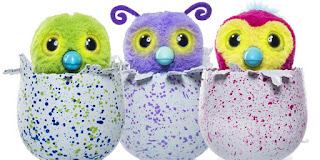There’s no doubt, aside from the hard to find NES Classic Edition, the “must have” toy of this holiday season had to be Hatchimals. If you don’t have kids or yours are some of the few who haven’t been begging for them for months, picture a friendlier version of a Furby hatching out of a giant bird’s egg.
Unlike previous iterations of “digital pets,” these manage to feel interactive. Hatchimals only come out after a good bit of coaxing by their new owners. And, once out, the better they are cared for, the more fun they become. If the owner plays with the Hatchimal, it will break out of its shell and begin to go through “normal” child development steps – talking, walking, spinning around.
Countless parents lined up to buy the limited number available in the weeks leading up to the holidays, so in came the market crashers, who bought up all they could find and now have them listed on Amazon and eBay. While some – mostly frustrated parents – condemn this price gouging, others look at it as simple capitalism. Nothing wrong with making a profit.
But the real interest here is why? What made this cross between a Furby and a Tamagotchi such a hit? A combination of something tried and true, with just enough new to make it appealing both to a new generation and to an older generation who grew up with fond memories of similar toys from when they were young.
This combination of nostalgia and wonder is toy marketing gold. Hatchimals absolutely nail the right mix of adorable and weird that kids love. Yes, they are cuddly and cute, but they are also bright neon dragon-penguin-koala hybrids, which definitely makes them stand out.
The next dynamic the toy makers behind this product got right is really understanding their target market. They wanted a “doll” that allowed owners to play with it and nurture it, but they needed something to appeal to today’s uber-connected digital-driven kids. A “pet” that can actually learn? It’s like having a younger sibling who won’t ever tattle to mom and dad … and this one is all your own.
Connecting that innate desire that so many kids have with something that will teach them responsibility – something all parents want them to learn – creates a dynamic that brings the target market, kids, together with the conduit to the market, mom and dad, in a way that has everyone saying “yes” by default.
Elie Hirschfeld is a real estate developer in NYC.

No comments:
Post a Comment